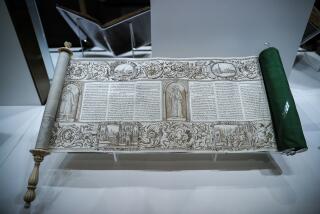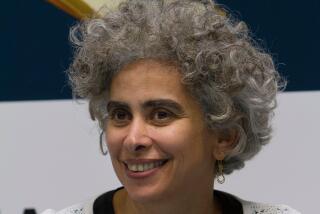Esther, the Silenced Singer
- Share via
Even when she was alive, Esther Kreitman’s novels, short stories and translations received far less attention than the work of her famous brothers, I. J. and Isaac Bashevis Singer. In death, she’s been wholly forgotten. Yet she clearly has the same deep, haunting, literary storyteller’s gifts as her siblings. Why do so few of us even know her name? Why is her work either lost or out of print? Why are people surprised to find out that the Singer brothers had a literary sister whose fiction appeared in English as well as Yiddish?
Hinde Esther Singer was born in Poland on March 31, 1881, the daughter of Bathsheva and Pinchos Mendel Singer. Bathsheva was an intellectual, but both Bathsheva’s father and her husband disapproved of erudite women. Bathsheva’s greatest failing, said her father, was that she had been born a woman. Both I. B. and I. J. Singer characterize Pinchos and Bathsheva’s marriage as a grave mismatch.
That they should then have a daughter who, like Bathsheva, turned out to crave an intellectual life was a tragedy to both parents. There was no place in the shtetl for a scholarly woman. Pinchos Mendel was determined not to repeat his father-in-law’s mistake of educating a daughter. As the child grew, Bathsheva became jealous of Hinde’s ambition, which filled Bathsheva with despair about her own unarticulated life. From the start, both husband and wife were determined to keep their daughter ignorant.
Indeed, Hinde Esther wasn’t only neglected; it seems she was ill-treated. At birth she was handed over to a wet nurse who lived “in a wretched hut.” She was “placed in a cot under a table,” says her son, Morris Kreitman (now known as Maurice Carr). “She was never touched, let alone fondled by her mother. Not until the age of three, when (she had become) blinded by cobwebs from under the table, was the child at last taken home, where she but partially recovered her sight, doomed to remain physically and psychically sick the rest of her life.”
Hinde Esther remained scorned by her parents through the remainder of her life, her role in the family, says Carr, that of “household drudge.” Still, despite their most zealous efforts, she turned out to be, as Isaac Bashevis Singer later remarked, a “ chassid in skirts”--perceived by the family as irrelevantly bookish and clever, too smart for a girl’s own good.
Her tragically strangled intellectual life made a lifelong impression on her brother Isaac Bashevis, younger by 13 years. His famous story, “Yentl the Yeshiva Boy” (which became Barbra Streisand’s movie “Yentl”)--about a girl who disguises herself as a boy so that she might receive an education--was inspired by Hinde Esther’s life. Indeed, much of I. B.’s fiction--for example, “Satan in Goray and the Manor”--takes Esther’s story even further, transmuting it into Singer’s own obsession with transsexuality. In “Satan in Goray,” a woman’s body is possessed by a dybbuk,so that she is simultaneously both man and woman.
“When my sister asked Mother what she should be when she grew up,” I. J. Singer wrote in his memoirs, “Mother answered her question with another: ‘What can a girl be?’ ” For girls from religious homes during these years, there was only one answer: to bring “happiness into the home by ministering to her husband and bearing him children.” Bathsheva, wanting to spare her daughter her own frustrations and unattainable dreams, believed that it was “better to be content as a dairy cow than to be a lost spirit.”
What little we know from Hinde Esther’s point of view must be culled from her fiction. In “Deborah,” Kreitman describes the protagonist’s spirit of revenge and determination:
“Almost every night, in bed, she firmly resolved to give up her duties of keeping house and to become a student instead. Ever since childhood she had longed to receive an education, to cease being the nonentity of the family. She would learn things, gain understanding . . . she, Deborah--the girl who, as her father had once said, was to be a mere nobody when she grew up--would be a person of real consequence. She would make her own life.”
In true life, Kreitman’s resolve to “be a person of real consequence” and to “make her own life” was more crippled and crippling than Deborah’s steely bedtime resolutions. Kreitman’s life turned out to be full of conflict, sacrifice and anguish.
Unable to shuck convention completely, and not “the kind of girl who could be married off easily (because she had) acquired some modern ideas, and read Yiddish newspapers and books, and longed for a romance, not an arranged marriage” (as Isaac Bashevis wrote), she eventually consented to an arranged match with a hapless diamond cutter from Antwerp named Avraham Kreitman. But she began, and remained, unhappy about the union.
“You’re sending me away because you hate me!” I. B. once wrote, describing Esther’s anger at her mother. Still, when Bathsheva--perhaps remembering her own unhappy marriage--offered to call off the wedding, Esther cried, “No. I’d rather go into exile. I’ll disappear. You won’t know what happened to my remains.” She entered her marriage, wrote I. B. Singer, like “a corpse . . . (but) in full possession of her senses.” One moment she looked upon her marriage as an escape, the next as an exile.
At the young age of 20, Hinde Esther already had written, according to I. J., an impressive collection of short stories. But Maurice Carr reports that “the thought of seeing them in print never entered her mind.” Esther had shown the stories only to I. J., and then to their mother--who read them without comment.
“At Bathsheva’s behest,” writes Carr, “on the train journey to the unhappy wedding in Berlin--lest the Czarist frontier officials suspect the Yiddish writings to be Socialist, seditious--Hinde Esther tore up the exercise books and threw the shreds out of the window.” Esther was trying, by sheer will and singular dramatized gesture, to accept her destiny as wife rather than writer.
Still, as time passed, Esther seemed unable to conquer her desire to write. Several times she left London (where the Kreitmans had settled) and her marriage, returning to Warsaw with the intention of embarking on a literary career. But, conflicted, she always ended up in London again. In 1929, she set out once more, leaving son and husband, with the stated purpose, says Carr, of living in Warsaw for good and “of mending her hitherto wasted life.”
After 10 months, Kreitman returned to England and began to publish short stories in the Yiddish dailies and literary journals of Warsaw, Paris, Antwerp, London, New York, Buenos Aires and Toronto.
In 1936, her first novel--”Der Shaidim Tantz” (literally, “The Devils’ Dance,” translated with the whitewashed title of “Deborah”)--was published in Poland. The English translation received enthusiastic reviews, though no one, of course, thought to comment on the meaning of Kreitman’s being the first female novelist to sing the praises of the Haskalah (the Jewish Enlightenment).
Her next novel, “Brillianten,” about the life among the Jewish diamond merchants of Antwerp, appeared in 1944, and again Kreitman garnered favorable notice. The distinguished critic Melech Ravitch mentioned its “rich descriptions” and “massive background of the outlandish Jewish way of life.” The review sounds terribly familiar--it could, indeed, be written in relation to any of the literary Singers’ work. Kreitman’s voice is distinctly Singeresque.
Interestingly, Kreitman, says her son, “never sought to make capital of her belonging to the Singer family; she kept herself to herself with the name Kreitman, which she had come by through her enforced and loveless marriage.” Not only did she lack a room of her own but also a name of her own.
By the time her third book came out, a collection of short stories entitled “Yichus,” Kreitman was used to the encouraging reviews and literary gatherings. Still, success failed to make her happy. She kept the reviews pasted in a book, but they seemed to make for only superficial pleasure.
Kreitman died in 1954 and, contrary to Jewish law, asked that she be cremated. She said that she dreaded what the shaidim that persecuted her in life might do to her body in the grave. She wanted to confound them after all, and have some victory, some peace.
Hinde Esther Kreitman is a forgotten literary foremother, her works largely lost, ignored and out of print. Isaac Bashevis Singer dedicated “The Seance” to her memory, but the proofreaders ( shaidim’s apprentice) were careless, and her name appeared as Minde Esther.
May she rest in peace.
More to Read
Sign up for our Book Club newsletter
Get the latest news, events and more from the Los Angeles Times Book Club, and help us get L.A. reading and talking.
You may occasionally receive promotional content from the Los Angeles Times.










